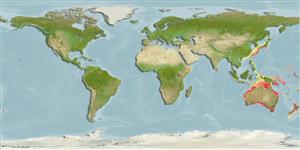Teleostei (teleosts) >
Anguilliformes (Eels and morays) >
Ophichthidae (Snake eels) > Myrophinae
Etymology: Scolecenchelys: Greek, skolex = worm (1855) + Greek, enchlys, -yos = eel (Ref. 45335).
More on author: Günther.
Environment: milieu / climate zone / depth range / distribution range
Ecology
Marine; reef-associated; depth range 0 - 156 m (Ref. 56887). Temperate
Eastern Indian Ocean: southern Australia, from Rottnest Island, Western Australia to Port Arthur, Tasmania. Southwest Pacific: New Zealand (Ref. 5755).
Size / Weight / Age
Maturity: Lm ? range ? - ? cm
Max length : 60.0 cm TL male/unsexed; (Ref. 9563)
Short description
Morphology | Morphometrics
Diagnosis: Moderately elongate with tail 58-63% of TL; dorsal fin arises slightly ahead of middle of preanal distance; blunt snout; large eye, 11-16 times in HL with posterior margin above or slightly in advance of corner of mouth; eye diameter less than interorbital distance; small, numerous teeth, conical and biserial anteriorly and uniserial posteriorly on jaws and vomer; color tan dorsally, pale ventrally, sharply delineated along mid-flank, anus not within a black spot; MVF 23/56/164; total vertebrae 161-167 (Ref. 56887).
Found inshore, in bays (Ref. 9563); burrowing, on soft bottoms (Ref. 7300). Caught under surface nightlights, and by trap, trawl, hook-and-line, and is occasionally discovered in fish stomachs; a benthic species living from tidepool depths to 156 meters (Ref. 56887).
Life cycle and mating behavior
Maturity | Reproduction | Spawning | Eggs | Fecundity | Larvae
May, J.L. and J.G.H. Maxwell, 1986. Trawl fish from temperate waters of Australia. CSIRO Division of Fisheries Research, Tasmania. 492 p. (Ref. 9563)
IUCN Red List Status (Ref. 130435)
Threat to humans
Harmless
Human uses
More information
Age/SizeGrowthLength-weightLength-lengthLength-frequenciesMorphometricsMorphologyLarvaeLarval dynamicsRecruitmentAbundanceBRUVS
ReferencesAquacultureAquaculture profileStrainsGeneticsElectrophoresesHeritabilityDiseasesProcessingNutrientsMass conversion
Tools
Special reports
Download XML
Internet sources
Estimates based on models
Preferred temperature (Ref.
123201): 14.4 - 18.5, mean 16.8 °C (based on 370 cells).
Phylogenetic diversity index (Ref.
82804): PD
50 = 0.5000 [Uniqueness, from 0.5 = low to 2.0 = high].
Bayesian length-weight: a=0.00076 (0.00029 - 0.00199), b=3.06 (2.83 - 3.29), in cm total length, based on LWR estimates for this (Sub)family-body shape (Ref.
93245).
Trophic level (Ref.
69278): 4.5 ±0.80 se; based on food items.
Resilience (Ref.
120179): Medium, minimum population doubling time 1.4 - 4.4 years (Preliminary K or Fecundity.).
Fishing Vulnerability (Ref.
59153): Moderate vulnerability (44 of 100).
Nutrients (Ref.
124155): Calcium = 13.2 [5.9, 24.4] mg/100g; Iron = 0.203 [0.108, 0.369] mg/100g; Protein = 19.1 [16.8, 21.7] %; Omega3 = 0.359 [0.154, 1.158] g/100g; Selenium = 10.9 [4.9, 24.7] μg/100g; VitaminA = 64.4 [17.0, 265.4] μg/100g; Zinc = 0.373 [0.242, 0.581] mg/100g (wet weight);
